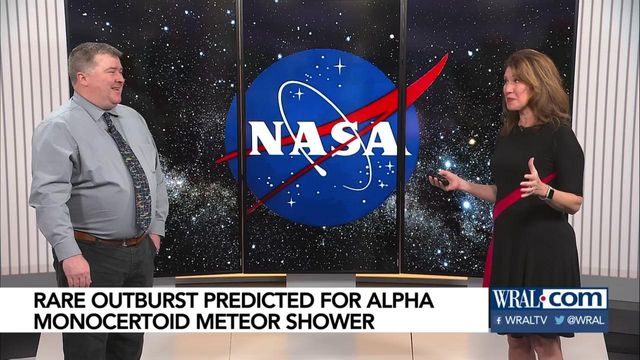Rare outburst predicted for 'unicorn' meteor shower
The alpha Monocertoid meteor shower has the potential to produce a quick flurry of long meteor trails over a few minutes on Thursday night ... or a dud.
Posted — UpdatedIt is worth checking out if just because it won’t require setting your alarm for the pre-dawn hours or standing out in the cold for very long.
You’ve probably never heard of this meteor shower. Most years, it produces a single observable meteor per night – not per hour, per night. It produced outbursts in 1925, 1935, 1985 and 1995, and a NASA scientist has created a model that suggests this could happen again this year.
That model, developed by meteor scientists Peter Jenniskens and Esko Lyytinen is a bit like a simplified version of the weather models used by the WRAL Weather team. It is used to predict when outbursts might occur. Meteor showers, especially ones that occur so infrequently are very hard to predict, but Jenniskens has literally written the book of meteor showers and the parent comets.
I also spoke with Bill Cooke of NASA's Meteoroid Environment Office in Huntsville, Ala., about prospects for the alpha Monocertoids. He monitors these things with the safety of NASA's spacecraft and astronauts in mind. Meteor showers are produced as Earth passes through a trail of dust and debris left by a passing comet. Bill reminded me that, for astronomers, an outburst is any meteor shower that produces significantly more meteors than usual. That doesn’t take much for the alpha Monocertoids.
You may have read estimates of 400 meteors per hour. Do not expect to see that many in an hour – or even all night. That is the calculated Zenith Hourly Rate (ZHR), a handicapping system of sorts, not an estimate of meteors that might be visible.
ZHR produces a best-case scenario. Astronomers use this number to compare observations across many locations and conditions.
For observers in western Africa, the radiant point, or area of the sky where meteors appear to be emanating from, will be nearly overhead. Here in the eastern U.S., that point will be low in the sky, hiding about half of the meteors below the horizon.
ZHR accounts for this and also removes the effects of light pollution, clouds, even time itself. That 400 ZHR was based on observations in 1985 and 1995, when more than 27 meteors were seen on a clear night over about four minutes.
The good news is that, unlike other meteor showers, which are best viewed in the hours before sunrise, the alpha Monocertoids will likely be over around midnight. You also won't have to invest much time. The shower is predicted to be active during a very narrow window centered at 11:50 p.m. EST Thursday. The moon will also be below the horizon at this time, increasing the number of meteors that might be seen.
Look east, beneath the Gemini and Orion constellations, beginning around 11:30 p.m. for meteors moving upward and along the horizon. If you’ve not seen anything by about 12:15 a.m. Friday, you probably won’t see any the rest of the night.
Related Topics
• Credits
Copyright 2024 by Capitol Broadcasting Company. All rights reserved. This material may not be published, broadcast, rewritten or redistributed.






